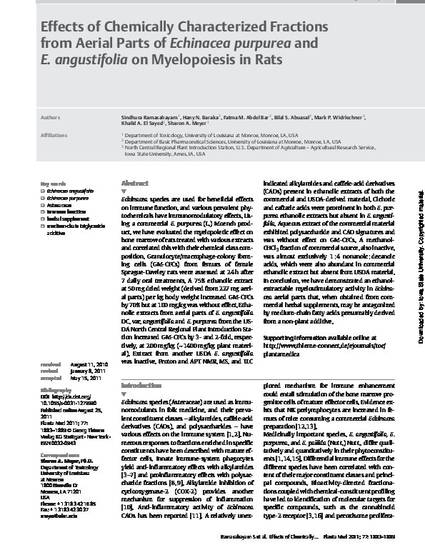
Article
Effects of Chemically Characterized Fractions from Aerial Parts of Echinacea purpurea and E. angustifolia on Myelopoiesis in Rats
Planta Medica
Document Type
Article
Disciplines
Publication Date
1-1-2011
DOI
10.1055/s-0031-1279990
Abstract
Echinacea species are used for beneficial effects on immune function, and various prevalent phytochemicals have immunomodulatory effects. Using a commercial E. purpurea (L.) Moench product, we have evaluated the myelopoietic effect on bone marrow of rats treated with various extracts and correlated this with their chemical class composition. Granulocyte/macrophage-colony forming cells (GM-CFCs) from femurs of female Sprague-Dawley rats were assessed at 24 h after 7 daily oral treatments. A 75 % ethanolic extract at 50 mg dried weight (derived from 227 mg aerial parts) per kg body weight increased GM-CFCs by 70 % but at 100 mg/kg was without effect. Ethanolic extracts from aerial parts of E. angustifolia DC. var. angustifolia andE. purpurea from the USDA North Central Regional Plant Introduction Station increased GM-CFCs by 3- and 2-fold, respectively, at 200 mg/kg (∼ 1400 mg/kg plant material). Extract from another USDA E. angustifoliawas inactive. Proton and APT NMR, MS, and TLC indicated alkylamides and caffeic-acid derivatives (CADs) present in ethanolic extracts of both the commercial and USDA-derived material. Cichoric and caftaric acids were prominent in both E. purpurea ethanolic extracts but absent in E. angustifolia. Aqueous extract of the commercial material exhibited polysaccharide and CAD signatures and was without effect on GM-CFCs. A methanol-CHCl3 fraction of commercial source, also inactive, was almost exclusively 1 : 4 nonanoic : decanoic acids, which were also abundant in commercial ethanolic extract but absent from USDA material. In conclusion, we have demonstrated an ethanol-extractable myelostimulatory activity in Echinacea aerial parts that, when obtained from commercial herbal supplements, may be antagonized by medium-chain fatty acids presumably derived from a non-plant additive.
Rights
Works produced by employees of the U.S. Government as part of their official duties are not copyrighted within the U.S. The content of this document is not copyrighted.
Language
en
File Format
application/pdf
Citation Information
Sindhura Ramasahayam, Hany N. Baraka, Fatma M. Abdel Bar, Bilal S. Abusal, et al.. "Effects of Chemically Characterized Fractions from Aerial Parts of Echinacea purpurea and E. angustifolia on Myelopoiesis in Rats" Planta Medica Vol. 77 Iss. 17 (2011) p. 1883 - 1889 Available at: http://works.bepress.com/mark_widrlechner/40/

This article is from Planta Medica 77, no. 17 (2011): 1883–1889, doi:10.1055/s-0031-1279990.